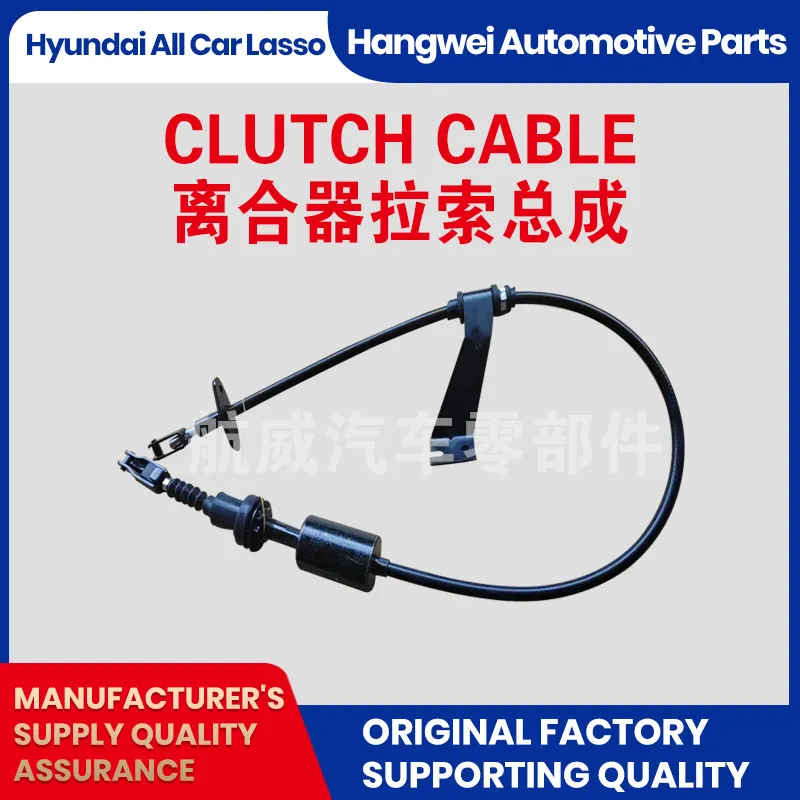Clutch Line | OEM-Fit, Leak-Free, High-Pressure Performance
Clutch Push-Pull Cable: a field-tested take on the modern clutch line
I’ve ridden along with mechanics in busy workshops, and one small part keeps steering the conversation: the humble clutch line. It’s not glamorous, but when pedal feel goes spongy or shifts get crunchy, everyone notices. HWEI’s Clutch Push-Pull Cable comes from Qinghe County Minjiang Street south, Wuzhishan Road east—an area that, funnily enough, many aftermarket buyers already associate with dependable control cables.
Industry trend? Lightweight conduits, low-friction liners, and corrosion-tough end fittings. Actually, fleets ask for one thing: predictable service life. That’s why this cable leans on a PTFE-lined Bowden design, stainless or zinc-nickel hardware, and tight process control. Many customers say the pedal effort “just feels right,” which, yes, sounds subjective—but it’s the kind of feedback that keeps repeat orders coming.

Where a robust clutch line matters
- Light commercial vans and last-mile delivery vehicles (stop/start, frequent shifts)
- Passenger cars with heavy urban cycles
- Small tractors, construction compacts, and utility vehicles
- Retrofit/restoration projects needing custom lengths and ends
Key specifications (real-world use may vary)
| Core wire | 7×7 or 7×19 steel strand, galvanized or stainless, φ ≈ 1.8–2.8 mm |
| Liner | PTFE low-friction sleeve inside HDPE/PA conduit |
| End fittings | Zinc-nickel plated steel or stainless; ball/clevis/barrel options |
| Stroke / length | Stroke ≈ 60–120 mm; overall length per drawing (±1.5 mm typical) |
| Min bend radius | ≥ 8× conduit OD (for longevity) |
| Operating temp | -40°C to +120°C continuous |
| Proof load | ≥ 1.2–1.8 kN (design-dependent) |
| Cycle life | ≥ 300,000 cycles at rated load (lab), target 500,000 in optimal routing |
Process flow (how it’s built and validated)
- Materials: selected steel strand (low stretch), PTFE liner, engineered conduit, OEM-grade fittings.
- Methods: precision strand cutting, swaged ends, crimp integrity checks, conduit pre-forming, anti-kink sleeves.
- Testing: tensile proof, dimensional checks, friction/effort curves, salt spray per ISO 9227/ASTM B117, thermal cycling per SAE J1455-like profiles.
- Service life: bench cycling under load; field validation on mixed urban/rural routes.
- Quality system: ISO 9001 and automotive-aligned practices; IATF 16949 compliant manufacturing approach.
Vendor comparison (quick buyer’s snapshot)
| Vendor | Certs | Customization | Salt Spray | Lead Time |
|---|---|---|---|---|
| HWEI (Qinghe) | ISO 9001, IATF 16949 (factory-level) | Ends, length, stroke, plating | ≥ 240–480 h (ISO 9227), spec-dependent | ≈ 2–4 weeks |
| Generic import | Basic ISO 9001 | Limited options | 96–240 h | 3–6 weeks |
| Local workshop | Varies | High (small batch) | Unspecified | Days–weeks |
Case study (fleet, 42 vans)
A courier fleet swapped in this clutch line after recurring fray failures. Post-install data over 9 months: downtime dropped ≈ 40%, pedal effort reduced ≈ 12% (average), and there were zero premature cable breaks. Mechanics noted easier routing thanks to tighter bend compliance. Not bad.
Customization and sourcing
From end types (ball, clevis, threaded) to plating stack-ups and sheath colors, the clutch line can be tailored to drawings or samples. Origin: Qinghe County Minjiang Street south, Wuzhishan Road east. Provide routing photos if you can—saves guesswork and improves cycle life.
Certifications, testing, and data points
- Quality system: ISO 9001; automotive QMS aligned with IATF 16949.
- Corrosion: ISO 9227 / ASTM B117 neutral salt spray; target ≥ 240 h for standard plating.
- Environmental: thermal shock, dust, and vibration guided by SAE J1455 profiles.
- Compliance: RoHS/REACH material screening on request.
Note: specifications are typical; confirm drawings and test plans for your application. Correct routing and bend radius dramatically affect service life.
Authoritative citations
- ISO 9227:2017, Corrosion tests in artificial atmospheres — Salt spray tests.
- ASTM B117-19, Standard Practice for Operating Salt Spray (Fog) Apparatus.
- SAE J1455:2017, Recommended Environmental Practices for Electronic Equipment Design in Heavy-Duty Vehicles.
- IATF 16949:2016, Automotive Quality Management System Requirements.
-
Clutch Line: Braided, Leak-Proof, OEM-Grade PerformanceNewsNov.10,2025
-
Throttle Cable: Durable, Smooth Control & Universal FitNewsNov.10,2025
-
Throttle Cable: Durable, Smooth, Universal Fit, Easy InstallNewsNov.10,2025
-
Clutch Line: Durable, Leak-Proof, OEM-Grade PerformanceNewsNov.10,2025
-
Hand Brake Cable | Custom, Universal & Trailer SolutionsNewsNov.10,2025
-
Clutch Line: High-Pressure, OEM-Fit, Corrosion-ResistantNewsNov.03,2025
